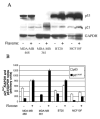Inhibition of cell proliferation, induction of apoptosis, reactivation of DLC1, and modulation of other gene expression by dietary flavone in breast cancer cell lines
- PMID: 17418982
- PMCID: PMC1950447
- DOI: 10.1016/j.cdp.2007.02.005
Inhibition of cell proliferation, induction of apoptosis, reactivation of DLC1, and modulation of other gene expression by dietary flavone in breast cancer cell lines
Abstract
Background: Dietary flavone was previously shown to increase the expression of deleted in liver cancer-1 gene (DLC-1) in HT-29 colon carcinoma cell line [Herzog A, Kindermann B, Doring F, Daniel H, Wenzel U. Pleiotropic molecular effects of the pro-apoptotic dietary constituent flavone in human colon cancer cells identified by protein and mRNA expression profiling. Proteomics 2004;4:2455-64]. DLC-1 that encodes a Rho GTPase-activating protein, functions as a tumor suppressor gene and is frequently inactivated or down-regulated in several common cancers. Restoration of DLC-1 expression suppresses in vitro tumor cells proliferation and tumorigenicity in vivo.
Methods: Here, the effect of flavone was examined in several DLC-1-deficient cell lines derived from different types human cancer using assays for cell proliferation, gene expression and transfer.
Results: We show that exposure to 150 microM flavone increased DLC1 expression in breast but not in liver or prostate carcinoma cells or a nonmalignant breast epithelial cell line. Flavone restored the expression of DLC1 in the breast carcinoma cell lines MDA-MB-468, MDA-MB-361, and BT20 as well as in the colon carcinoma cell line HT-29 all of which are DLC-1-negative due to promoter hypermethylation. We further show that flavone inhibited cell proliferation, induced cell cycle arrest at G(2)-M, increased p21(Waf1) gene expression, and caused apoptosis. Microarray analysis of these aggressive and metastatic breast carcinoma cells revealed 29 flavone-responsive genes, among which the DNA damage-inducible GADD genes were up-regulated and the proto-oncogene STMN1 and IGFBP3 were down-regulated.
Conclusions: Flavone-mediated alterations of genes that regulate tumor cell proliferation, cell cycle, and apoptosis contribute to chemopreventive and antitumoral effects of flavone. Alone or in combination with demethylating agents, flavone may be an effective adjunct to chemotherapy in preventing breast cancer metastasis.
Figures







Similar articles
-
[The role of mitogen-activated protein kinase cascades in inhibition of proliferation in human prostate carcinoma cells by raloxifene: an in vitro experiment].Zhonghua Yi Xue Za Zhi. 2008 Jan 22;88(4):271-5. Zhonghua Yi Xue Za Zhi. 2008. PMID: 18361842 Chinese.
-
Inhibitory effects of deleted in liver cancer 1 gene on gallbladder cancer growth through induction of cell cycle arrest and apoptosis.J Gastroenterol Hepatol. 2014 May;29(5):964-72. doi: 10.1111/jgh.12486. J Gastroenterol Hepatol. 2014. PMID: 24329682
-
Flavone inhibits migration through DLC1/RhoA pathway by decreasing ROS generation in breast cancer cells.In Vitro Cell Dev Biol Anim. 2016 May;52(5):589-97. doi: 10.1007/s11626-016-0010-8. Epub 2016 Mar 2. In Vitro Cell Dev Biol Anim. 2016. PMID: 26935193
-
Deleted in liver cancer-1 (DLC1): an emerging metastasis suppressor gene.Mol Diagn Ther. 2014 Jun;18(3):293-302. doi: 10.1007/s40291-014-0086-3. Mol Diagn Ther. 2014. PMID: 24519699 Free PMC article. Review.
-
Deleted in liver cancer-1 (DLC-1): a tumor suppressor not just for liver.Int J Biochem Cell Biol. 2008;40(5):843-7. doi: 10.1016/j.biocel.2007.04.008. Epub 2007 Apr 20. Int J Biochem Cell Biol. 2008. PMID: 17521951 Free PMC article. Review.
Cited by
-
DLC-1 as a modulator of proliferation, apoptosis and migration in Burkitt's lymphoma cells.Mol Biol Rep. 2011 Mar;38(3):1915-20. doi: 10.1007/s11033-010-0311-z. Epub 2010 Oct 1. Mol Biol Rep. 2011. PMID: 20882354
-
Molecular Responses of the Eukaryotic Cell Line INT407 on the Internalized Campylobacter jejuni-The Other Side of the Coin.Pathogens. 2024 May 7;13(5):386. doi: 10.3390/pathogens13050386. Pathogens. 2024. PMID: 38787238 Free PMC article.
-
Proteomic analysis of differentially expressed proteins in hepatitis B virus-related hepatocellular carcinoma tissues.J Exp Clin Cancer Res. 2009 Aug 28;28(1):122. doi: 10.1186/1756-9966-28-122. J Exp Clin Cancer Res. 2009. PMID: 19715608 Free PMC article.
-
Expression of deleted in liver cancer 1 and plasminogen activator inhibitor 1 protein in ovarian carcinoma and their clinical significance.J Exp Clin Cancer Res. 2013 Aug 30;32(1):60. doi: 10.1186/1756-9966-32-60. J Exp Clin Cancer Res. 2013. PMID: 23988121 Free PMC article.
-
Flavonoid C-glucosides Derived from Flax Straw Extracts Reduce Human Breast Cancer Cell Growth In vitro and Induce Apoptosis.Front Pharmacol. 2016 Aug 31;7:282. doi: 10.3389/fphar.2016.00282. eCollection 2016. Front Pharmacol. 2016. PMID: 27630565 Free PMC article.
References
-
- Yuan BZ, Miller MJ, Keck CL, Zimonjic DB, Thorgeirsson SS, Popescu NC. Cloning, characterization, and chromosomal localization of a gene frequently deleted in human liver cancer (DLC-1) homologous to rat RhoGAP. Cancer Res. 1998;58:2196–99. - PubMed
-
- Seng TJ, Low JS, Li H, Cui Y, Goh HK, Wong ML, et al. The major 8p22 tumor suppressor DLC1 is frequently silenced by methylation in both endemic and sporadic nasopharyngeal, esophageal, and cervical carcinomas, and inhibits tumor cell colony formation. Oncogene advance online publication. 2006 July 24; doi: 10.1038/sj.onc.1209839. - DOI - PubMed
-
- Syed V, Mukherjee K, Lyons-Weiler J, Lau KM, Mashima T, Tsuruo T, et al. Identification of ATF-3, caveolin-1, DLC-1, and NM23-H2 as putative antitumorigenic, progesterone-regulated genes for ovarian cancer cells by gene profiling. Oncogene. 2005;24:1774–87. - PubMed
-
- Wong CM, Yam JW, Ching YP, Yau TO, Leung TH, Jin DY, et al. Rho GTPase-activating protein deleted in liver cancer suppresses cell proliferation and invasion in hepatocellular carcinoma. Cancer Res. 2005;65:8861–68. - PubMed
Publication types
MeSH terms
Substances
Grants and funding
LinkOut - more resources
Full Text Sources
Other Literature Sources
Medical
Research Materials
Miscellaneous

